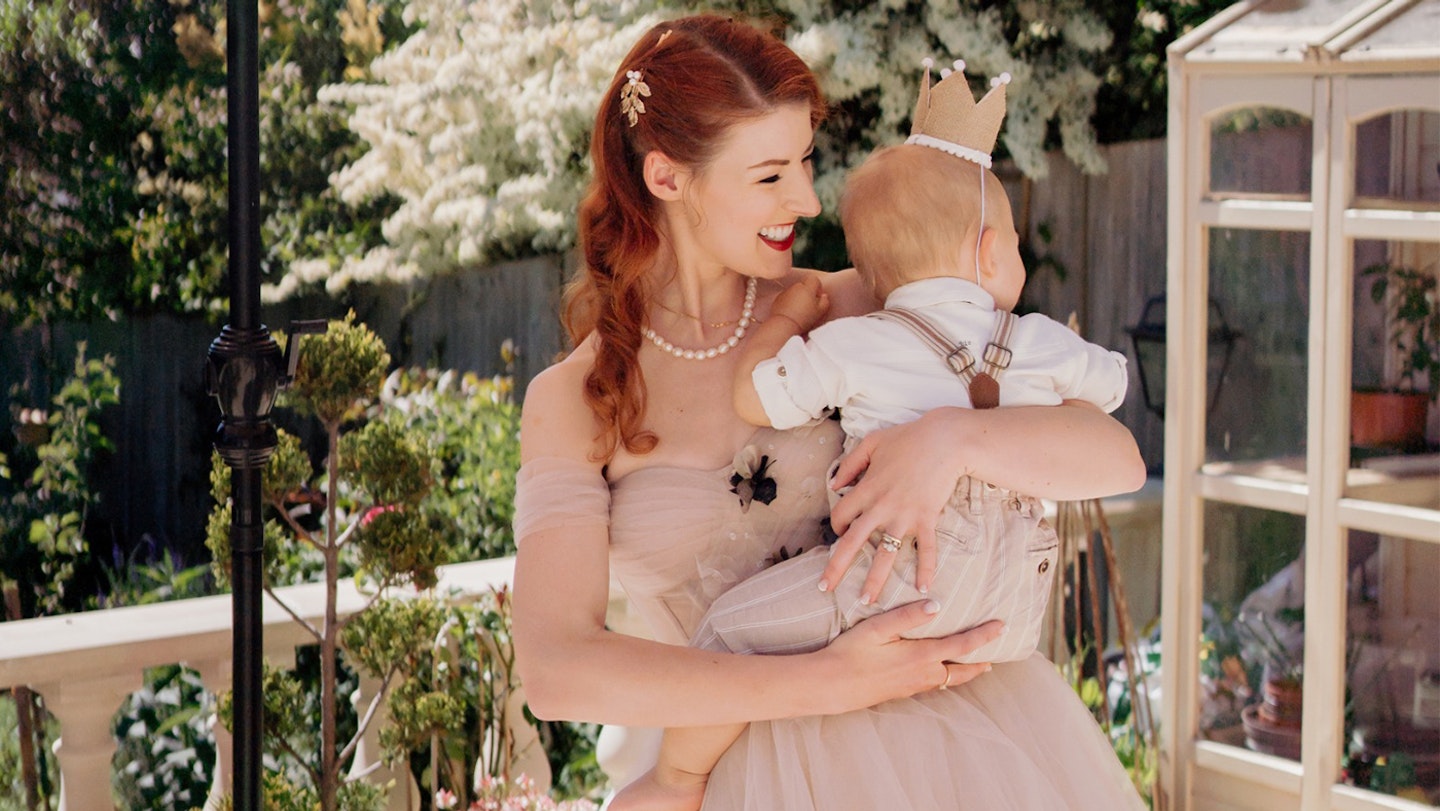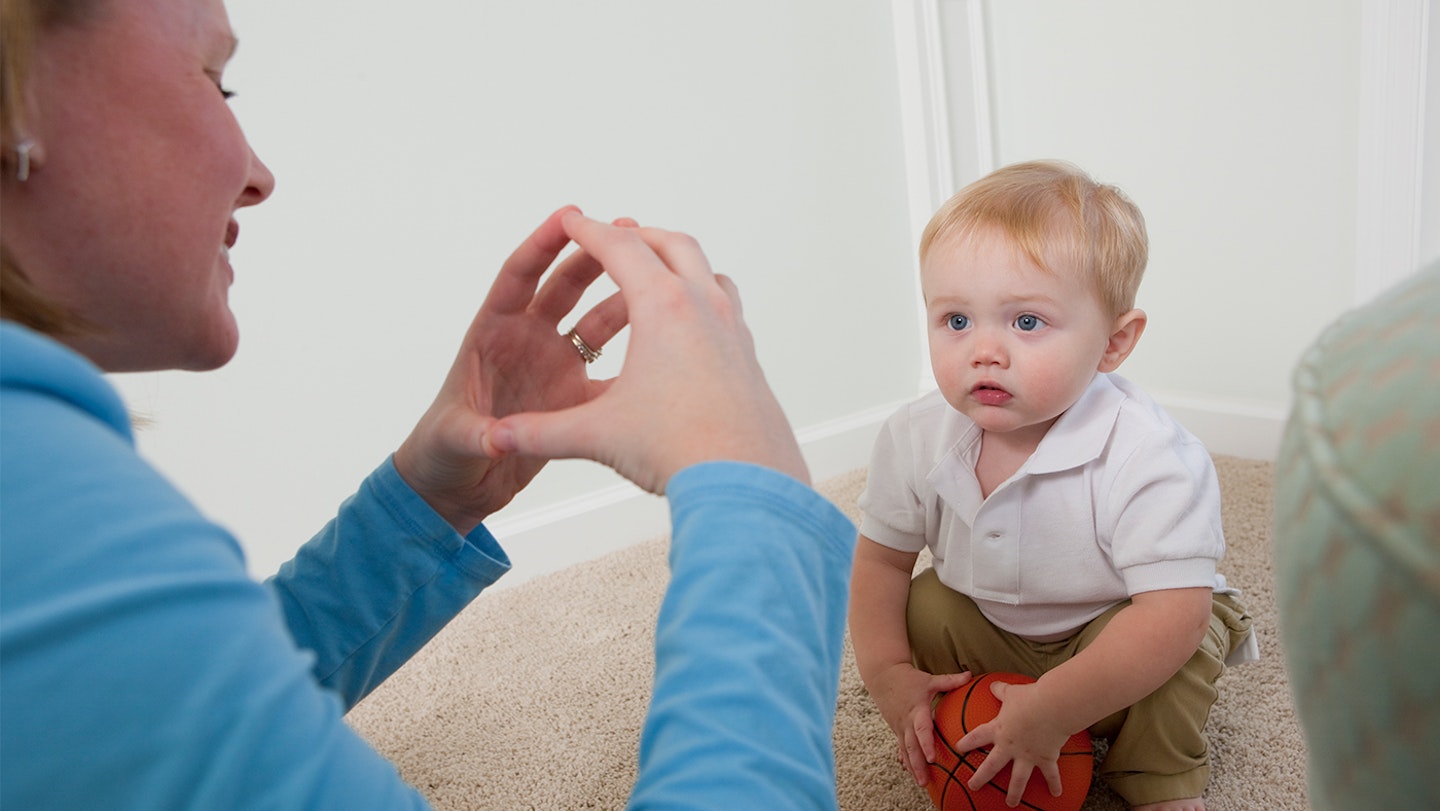We all sometimes stare at our bawling baby and wish they could just tell us what they need… but what if that was actually possible?
What if our tiny child, whose voice box is not yet mature enough to make recognisable words, could be given another way to make themselves understood rather than crying?
Long before my wife and I had our son, Rupert, 16 months ago we’d already discussed the importance of bringing him up with both speech and sign language from birth (should he be born hearing). Quite frankly, as a deaf person who wears hearing aids and relies on lip reading, in my day-to-day life communication for me can be an energy-draining struggle and my home is my relaxing space! I wanted to be able to chat to my family at the end of the day without needing to intensely focus on their lips. I want to be understood easily and without frustrating miscommunication.
And that’s exactly what babies want too. So how can we help them?
Our receptive language skills develop far earlier than expressive language skills and along with motor function, the auditory perceptual abilities needed to articulate speech simply are not developed enough to produce words until around 10 to 12 months of age — although obviously some babies do things a little earlier and some are later. From there our language skills take years to fully establish.
Rupert first signed back the word ‘change’ at 12 weeks old, though he was only mimicking what we were saying in front of him. It was at around seven months old that his signing took off and he began to use the language of his own accord: asking for ‘more’, saying which of his parents he wanted (it’s always the one not in the room, right?), requesting a ‘rattle’, or letting us know he did indeed need a ‘change’.

Now at 16 months old Rupert has around sixty signs. There are some words he signs only, some words he vocalises only (often because the sign is quite complex for him), and some words he both signs and speaks. There are also other words for which he hasn’t grasped or doesn’t know the sign but will instead reach for the prominent sound such as signing ‘B’ for ‘biscuit’. He has been able to string signed words together for quite a few months.
I started to lose my hearing as a teenager and had to begin teaching myself sign language from books, which is NOT a great way to learn a language based on movement! But I feel that having access to such a rich and multifaceted language from such a young age has opened up parts of Rupert’s brain in an unexpected way.
There have been benefits in his language skills, yes: he refers to teddy bears with the sign ‘bear’ but his own favourite teddy with ‘my bear’. The sign for ‘mine’ is a closed hand to the chest whilst the sign for ‘yours’ is a closed hand outwards- undoubtedly helpful to learning about possessives in a tangible way. Vocalise “you did it” and he’ll chirp “I did it!”
But the benefit I wasn’t expecting was a special bond that forms in the moments where he translates the world for me. I haven’t yet explained to him that I’m deaf, I haven’t sat down and shown him my hearing aids, I haven’t explicitly told him I can’t hear… yet whenever there is a loud noise, he taps my arm, gets my attention and signs ‘hear’ if he doesn’t know what it is, ‘bark’ for a dog or ‘car’ if it’s an engine. He also occasionally before starting to play with me will stick his finger into my ear to check for my hearing aid and if he doesn’t find it will ever so slightly alter his behaviour — mainly by sitting right in front of me and frantically signing to me every single time the dogs so much as move a paw!
We began using sign language from day 0, before he had even started opening his eyes (which took him probably a good week, bless him!) and were very consistent. Although we did follow the standard bilingual child practice of one parent speaking one language and the other parent speaking the other language, Claudia does use key signs with Rupert whilst she’s talking to him and the two of us will have conversations in sign in front of him to make sure he sees a good back and forth. An example of key signs would be for the sentence “you seem thirsty, do you want your water beaker?” I would sign the full sentence whilst she would instead vocalise it with the addition of signing ‘drink’.
One great help to pouring fluency of language into him was reading books in sign language.I’m naturally the storyteller between us and I love children’s books so reading to Rupert was a joy of mine but if you’re intending on bringing up a child to be bilingual, making sure that their bookshelf is full of books that are either not written in or aren’t read to them in the dominant language of the culture/house they live in really helps them learn the flow of language rather than just random words from a flash card.
Whether it’s British Sign Language, American Sign Language or one of the more than 300 other sign languages in the world, they are all rich and vibrant ways of communicating that are, yes, REAL languages and need to be experienced at their fullest — a single sign won’t tell you much without the lip pattern, the body language, the feeling behind it.
Teaching your baby genuine sign languages rather than ‘baby sign language'means that they won’t age out of it but can go on to master another language at a young age and then communicate with those around them who use sign language as their primary language. They’ll be able to make friends at school or the park with children who sign. Plus the majority of deaf children are born into hearing families- your child may go on to have a deaf cousin or even a deaf sibling, how great that as a family you’ve already started learning!
Sign language is also really wonderful for children whose brains are already wired a little differently and are visual rather than verbal communicators. Not only deaf children but those with autism, speech disorders and other forms of cognitive difference. You won’t know if your infant is included in this group when you start signing to them as an infant but how wonderful that you’re already giving them a tool that can help.

When children are taught spoken language and sign language together, they are processing language using both sides of the brain. This gives them two places to recall language from instead of just one. Here is language presented in a tactile, kinesthetic, and visual way.
No wonder research supports that hearing children who are taught sign language from an early age have better reading and spelling skills. For one thing — we spell out the words we don’t have a sign for! Like ‘apricot’. He currently really likes apricots so he’s developing an interest in words beginning with ‘a’ and finding things that give him opportunities for spelling out that sound.
It’s commonly said that teaching your child ‘Baby Sign’ cuts down on frustration as they are able to communicate earlier and whilst it is true that your baby being able to ask for what they need (in any language) definitely cuts down on the crying and makes for a more harmonious home, it definitely isn’t a magic trick to no more tears! You do need to be sharp sometimes in trying to decipher your baby’s signs (as you do with their babbles), bear in mind that they have tiny hands and fingers that aren’t yet as dexterous as ours and that they will struggle to exactly match your handshapes for some signs. Just yesterday my wife had to run to find me as my son was in floods of tears because she didn’t understand what he was trying to sign and he couldn’t understand why she wasn’t getting it! So no, sign language does not remove every communication frustration.
You also need to be consistent: don’t expect your baby to continue to use sign language if you stop signing to them. And whilst you definitely don’t need to have everyone in your life know all of the signs your child uses, it’s important that they at least understand the ‘get me out of this situation' ones like when they’re calling for a parent or saying they’re all done.
What’s crucial to know is that whilst teaching babies sign language has in recent years become very popular, for many decades deaf children were denied access to the language as medical and educational professionals encouraged only the use of speech, believing signing to be a crutch for spoken language and a barrier for full language acquisition. It’s wonderful that hearing children are able to gain so much from sign language but let’s make sure that they are also developing a full sense of why sign language exists and who else they can be benefiting from growing up learning a comprehensive version of the language.
Sounds scary? Start small and find some online resources from deaf creators in your local sign language. There will likely be online classes available run by people who have likely been signing their whole lives. If you’re American then try the Baby Einstein signing videos, which star the deaf actress Marlee Matlin, and if you’re British try the BSL children’s section of BBC iPlayer.
Meet the expert: Jessica Kellgren-Fozard is a vintage icon and leading advocate for LGBTQ+ and disability rights. Jessica’s unique sense of personal style, coupled with her blend of creativity and intellect, has amassed her a legion of fans.
Since Jessica and her wife Claudia had baby Rupert in summer 2021, Jessica expanded her ever-growing roster of educational videos and began talking about her experience being a Deaf & Disabled parent - bringing tips, tricks and educating her viewership on things like sign language for babies & Montessori parenting.
